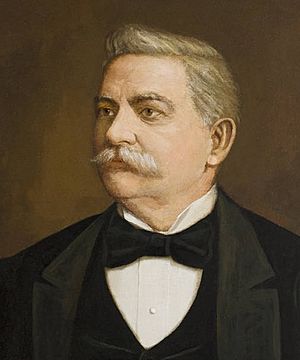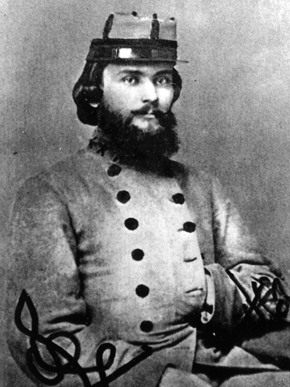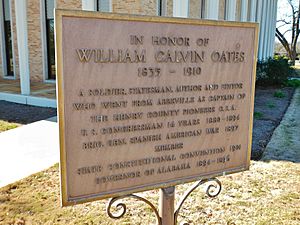William C. Oates facts for kids
Quick facts for kids
William C. Oates
|
|
|---|---|
 |
|
| 29th Governor of Alabama | |
| In office December 1, 1894 – December 1, 1896 |
|
| Preceded by | Thomas G. Jones |
| Succeeded by | Joseph F. Johnston |
| Member of the U.S. House of Representatives from Alabama's 3rd district |
|
| In office March 4, 1881 – November 5, 1894 |
|
| Preceded by | William J. Samford |
| Succeeded by | George Paul Harrison, Jr. |
| Member of the Alabama House of Representatives | |
| In office 1870–1872 |
|
| Personal details | |
| Born | November 30, 1835 Pike County, Alabama |
| Died | September 9, 1910 (aged 74) Montgomery, Alabama |
| Resting place | Oakwood Cemetery |
| Political party | Democratic |
| Military service | |
| Allegiance | |
| Branch/service |
|
| Years of service |
|
| Rank |
|
| Commands | |
| Battles/wars | |

William Calvin Oates (born in 1835, died in 1910) was an important figure in American history. He served as a high-ranking officer, a colonel, in the Confederate States Army during the American Civil War. Later, he became the 29th Governor of Alabama from 1894 to 1896. He also served as a brigadier general in the U.S. Army during the Spanish–American War.
Contents
Early Life and Education
Oates was born in Pike County, Alabama. His parents, William and Sarah Oates, were a farming family who did not have much money. All of his family members came to North America during the early colonial times. They were from England and Wales.
When he was 17, Oates left home and traveled to Florida. He then lived in Texas for a few years. His younger brother, John, convinced him to return to Alabama. Oates then studied law at the Lawrenceville Academy in Lawrenceville. He passed his law exam and started his own law office in Abbeville.
Service in the Civil War
William C. Oates joined the Confederate States Army in July 1861. He started as a Captain in the 15th Alabama Infantry Regiment. By the spring of 1863, he became the commander of the 15th Alabama Infantry Regiment.
Battle of Gettysburg
Oates and his troops fought bravely in the Battle of Gettysburg. He led his soldiers in several attacks on a key hill called Little Round Top. During this battle, his brother John was killed. Oates believed that if his regiment had captured Little Round Top, the Confederate Army might have won the battle. He thought they could have then marched on to take Washington, D.C.
Oates later said that if just one more Confederate regiment had joined their attack, they could have succeeded. This would have helped the Confederate forces turn the U.S. Army's side. He believed it would have threatened the entire Army of the Potomac.
Oates explained:
His [Col. Chamberlain's] skill and persistence and the great bravery of his men saved Little Round Top and the Army of the Potomac from defeat.
[If one more Confederate regiment had stormed the far left of the Army of the Potomac with the 15th Alabama,] "...we would have completely turned the flank and have won Little Round Top, which would have forced Meade's whole left wing to retire." He concluded, philosophically, that "great events sometimes turn on comparatively small affairs."
Later Battles and Injury
Oates also fought in other major battles. These included Chickamauga, the Wilderness, Spotsylvania Court House, and Cold Harbor. He lost command of the 15th Alabama due to a political decision. However, Confederate President Jefferson Davis then made him a colonel of the 48th Alabama.
Oates was injured during the Battle of Fussell's Mill, near Richmond. He lost his right arm, which meant he could no longer serve actively in the war.
Life After the War
After the Civil War, Oates went back to his law practice in Henry County, Alabama. He was chosen to represent his state at the 1868 Democratic National Convention. From 1870 to 1872, he served in the Alabama House of Representatives.
In 1880, Oates was elected to the U.S. House of Representatives. He served there for seven terms in a row. On March 28, 1882, Oates married Sarah Toney from Eufaula. They had one son, William Calvin, Jr., who later joined his father in the law business.
Governor and General
Oates was elected governor of Alabama in 1894. It was a very competitive election. Two years later, he tried to become a candidate for the United States Senate, but he was not successful.
In 1898, President William McKinley made Oates a brigadier general. He then served in the Spanish–American War. After his military service, he returned to his law practice. He also invested in real estate. Oates tried to have a monument built at Gettysburg to honor his comrades from the 15th Alabama, including his brother. However, he was not successful.
William Calvin Oates passed away in Montgomery. He was buried in Oakwood Cemetery.


